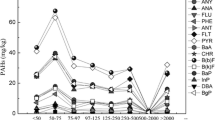Abstract
In order to evaluate the mixing effect of NaCl and surfactant on the remediation of TCB contaminated soil, column experiments were performed. Selected soils for this study were two Iowa field soils (Fruitfield, and Webster) and one Korea field soil (Pyeongtaek). We used four nontoxic, water-soluble anionic (DOSL, SLS) and nonionic surfactants (POE20, POE4). 1, 2, 4-trichlorobenzene (TCB) was chosen as the model contaminant. Selected electrolyte for this study was NaCl. The TCB contaminated soils were leached with surfactant solution of 4% (v/v) or 4% (w/v) with or without 5% (w/v) and 10% (w/v) NaCl. As controls, TCB contaminated soils were also leached with deionized water. For the nonionic surfactants (POE20, POE4), the mixing effect of NaCl on the solubilization of contaminant was insignificant. However, much greater mixing effectiveness was observed using anionic surfactant (SLS, single head structure) solutions containing electrolyte (NaCl) from two Iowa soils and one Korea soil. In contrast, another anionic surfactant (DOSL, double head structure) had little mixing effectiveness on the solubilization of TCB from three soils. However, the NaCl mixing effect of DOSL anionic surfactant was found after leaching of 2500 ml solution with Pyeongtaek soil. The effect of NaCl in changing effectiveness was due to Na+ (counterion) effects. The maximum recovery of added TCB in column tests was 97% for 4% (w/v) aqueous SLS anionic surfactant + 10% (w/v) NaCl. A little effectiveness of 4% (v/v) DOSL (anionic surfactant) with electrolytes may be due to small adsorption of the double-head sulfate polar heads onto soil particles. Therefore, these results showed that the key factor in the variation of TCB removal effect due to surfactant + NaCl leaching was not surfactant types but surfactant structure. Also, results of this study suggest that the anionic surfactant (SLS) solutions containing electrolyte (NaCl) is a good candidate for surfactant-assisted remediation of TCB contaminated soil.
Similar content being viewed by others
References
Allred, B. and Brown, GO., 1994, Surfactant-induced reductions in soil hydraulic conductivity. Ground Water Monitoring and Remediation, 14, 174–184.
Bystryak, S.M., Winnik, M.A. and Siddiqui, J., 1999, Unusual conductivity changes for sodium dodecyl surfate solutions in the preserve of polyethyleneimine and polyvinylamine. Langmuir, 15, 3748–3751.
Chen, L. and Knox, R.C., 1997, Using vertical circulation wells for partitioning tracer tests and remediation of DNAPLs. Ground Water Monitoring and Remediation, 17, 161–168.
Chu, W. and Kwan, C.Y., 2003, Remediation of contaminated soil by a solvent/surfactant system. Chemosphere, 53, 9–15.
Cihacek, L.J. and Bremner, J.M., 1979, A simplified ethylene glycol monoethyl ether procedure for Assessment of soil surface area. Soil Science Society America Journal, 43, 821–822.
Cort, T.L, Song, M.-S. and Bielefeldt, A.R., 2002, Nonionic surfactant effects on pentachlorophenol biodegradation. Water Research, 36, 1253–1261.
Deshpande, S., Wesson, L., Wade, D., Sabatini, D.A. and Harwell, J.H., 2000, Dowfax surfactant components for enhancing contaminant solubilization. Water Research, 34, 1030–1036.
Edwards, D.A., Liu, Z. and Luthy, R.G., 1994, Surfactant solubilization of organic compounds in soil/aqueous systems. Journal of Environmental Engineering, 120, 5–21.
Gee, G.W. and Bauder, J.W., 1986, Particle-size analysis. In: Klute A, editor. Methods of soil analysis. Part 1 2nd ed. Argon Monogr 9. Madison (WI); ASA and SSSA, 383–412.
Harwell, J.H., Sabatini, D.A. and Knox, R.C., 1999, Surfactants for ground water remediation. Colloids and Surfaces (A), 151, 255–268.
Henry, E.J. and Smith, J.E., 2002, The effect of surface-active solutes on water flow and contaminant transport in variably saturated porous media with capillary fringe effects. Journal of Contaminant Hydrology, 56, 247–270.
Hiemenz, P.C., 1986, Principles of colloid and surface chemistry. 2nd ed. Marcel Dekker Inc., New York
Jafvert, C.T. and Heath, J.K., 1991, Sediment and saturated soil associated reactions involving an anionic surfactant (dodecylsulfate): 1. Precipitation and micelle formation. Environmental Science and Technology, 25, 1031–1038.
Lee, D.-H., 1999, Experimental investigation of the removal of hydrophobic organic compounds from two Iowa soils using food grade surfactants and recovery of used surfactants. Ph.D. Dissertation. Iowa State University, Ames, IA, 200 pp.
Lee, D.-H., Cody, R.D. and Hoyle, B.L., 2001, Laboratory evaluation of the use of surfactant for ground water remediation and the potential for recycling them. Ground Water Monitoring and Remediation, 21, 49–57.
Lee, D.-H., Cody, R.D., Kim, D.J. and Choi, S.C., 2002, Effect of soil texture on surfactant-based Remediation of hydrophobic organic-contaminated soil. Environment International, 27, 681–688.
Martel, R. and Gelinas, P.J., 1996, Surfactant solutions developed for NAPL recovery in contaminated aquifers. Ground Water, 34, 143–154.
Mebius, L.J., 1960, A rapid method for the determination of organic carbon in soils. Anal ChimActa, 22, 120–124.
Park, S.-K. and Bielefeldt, A.P., 2003, Equilibrium partitioning of a non-ionic surfactant and pentrachlorophenol between water and a non-aqueous phase liquid. Water Research, 37, 3412–3420.
Rajput, V.S., Higgins, A.J. and Singley, M.E., 1994, Cleaning of excavated soil contaminated with hazardous organic compounds by washing. Water Environmental Research, 66, 819–827.
Rosen, M.J., 1989, Surfactants and interfacial phenomena. John Wiley & Sons, New York.
Rouse, J.D., Sabatini, D.A. and Harwell, J.H., 1993, Minimizing surfactant losses using twin-head anionic surfactants in subsurface remediation. Environmental Science and Technology, 27, 2072–2078.
Sabatini, D.A., Knox, R., Harwell, J.H., Soerens, T., Chen, L., Brown, R.E. and West, C.C., 1997, Design of a surfactant remediation field demonstration based on laboratory and modeling studies. Ground Water, 35, 954–963.
Shiau, B.J., Sabatini, D.A. and Harwell, J.H., 1995, Properties of food grade (edible) surfactants affecting subsurface remediation of chlorinated solvents. Environmental Science and Technology, 29, 2929–2935.
Zhong, L., Mayer, A.S. and Pope, G.A., 2003, The effects of surfactant formulation on nonequilibrium NAPL solubilization. Journal of Contaminant Hydrology, 60, 55–75.
Author information
Authors and Affiliations
Corresponding author
Rights and permissions
About this article
Cite this article
Lee, DH., Chang, HW. & Kim, C. Mixing effect of NaCl and surfactant on the remediation of TCB contaminated soil. Geosci J 12, 63–68 (2008). https://doi.org/10.1007/s12303-008-0008-7
Received:
Accepted:
Published:
Issue Date:
DOI: https://doi.org/10.1007/s12303-008-0008-7




